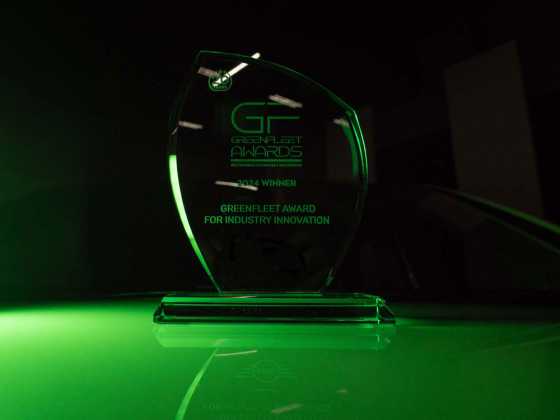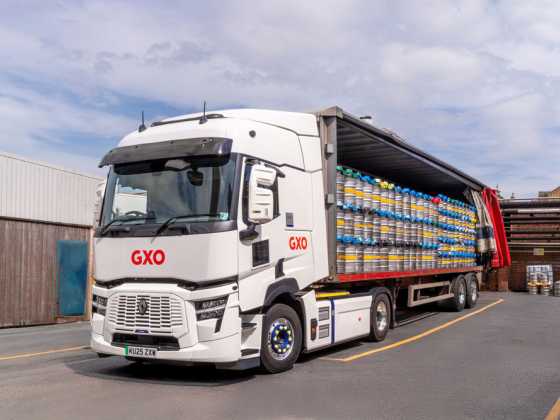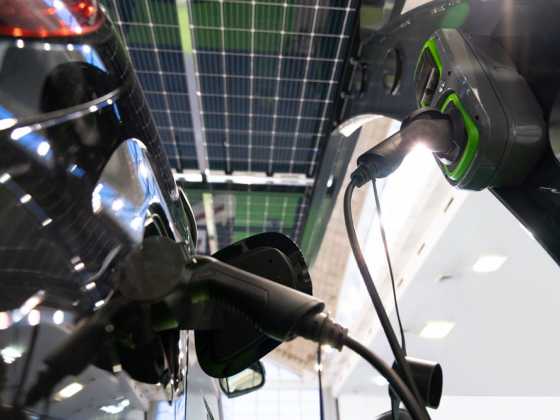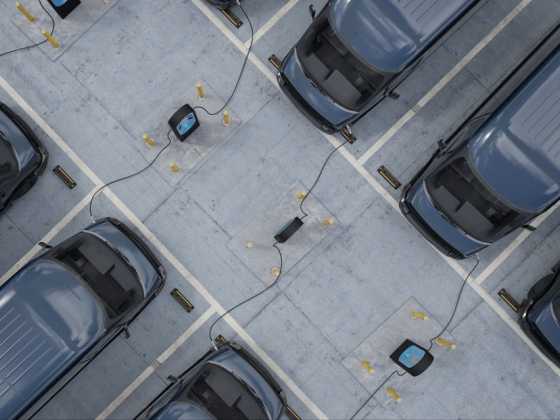The Electric Fleet Race 2024: six months on

Half a year into the Electric Fleet Race and a number of inspiring fleets, large and small, have been identified as either leading the way in fleet electrification nationally, or within their sector. As media partner, GREENFLEET takes a look at the fleets recognised so far.
The Electric Fleet Race – powered by Rightcharge, is a monthly insight into which UK organisation is leading the way in terms of Battery Electric Vehicle (BEV) numbers on fleet, split nationally and also divided into sector.
Charlie Cook, CEO of Rightcharge, explains the thinking behind the initiative: “The Electric Fleet Race initiative was inspired by the amazing fleets we work with. We saw the remarkable progress these fleets are making on their electrification journey and wanted to shine a light on their outstanding efforts. The Electric Fleet Race aims to showcase these businesses and share success stories to demonstrate that electrification is possible for any business, at any size.”
Recognising electrification success
Currently, The National Grid is leading nationally for the amount of electric cars – with a massive 1,731 on fleet. With the addition of 412 electric vans, the organisation is making great strides towards its ambition of having a fully electric fleet by 2030 for its light-duty vehicles.
Lorna McAtear, UK fleet manager at National Grid, observed that despite large numbers of EVs, the learning process still goes on. She said: “It doesn’t seem to matter how many full electric cars we have, there is always something still to learn and something to give back to others. This commitment and leadership underscores the dedication to sustainable practices and innovation in the transport and energy sector. I’m eagerly waiting for someone to overtake me!”
OVO remains first place nationally for the number of electric vans, at 87 per cent – making its aim of being fully electric nearly complete.
S-J Mitchell, senior fleet & supply chain manager, said: “OVO was born to make energy better for people and the planet and we are getting ready for a greener, fairer future by becoming a true net zero business by 2035. This progress is very visible when you look at our growing fleet of battery powered electric vehicles.
“Back in 2021 we recognised the need to solve pollution challenges for our customers and the communities we serve. Committing to replace all our diesel and petrol vehicles with electric is a cornerstone of our sustainability commitments.
“Having nearly completed the transition to be an EV fleet, I am proud to look back and be so much more familiar with the economics, charging needs and other characteristics that are crucial to successfully pivot to electric. We travel over six million miles per year, so knowing our fleet isn’t contributing to the worst impacts of climate change, while making sound business sense for OVO, feels good.”
Local authority and public sector
The London Borough of Islington is currently leading the Electric Fleet Race in the local authority category for its 28 electric cars, 38 electric vans, and 28 electric specialist vehicles.
The Council also picked up March’s award in the Specialist Vehicle category, in recognition of its electric refuse collection vehicles, cage tippers, street sweepers and electric minibuses. This electrification success is boldly progressing the council towards its goal of having a fully zero-emission fleet by 2030.
Chris Demetriou, assistant director of corporate fleet at London Borough of Islington said: “We’re absolutely thrilled to currently lead the electric fleet race in the Local Authority category. Additionally, we’re honoured to be recognised in the Specialist Vehicle category as we continue transitioning our fleet of 500+ vehicles to full battery electric. Our entire fleet team, from workshop technicians to project and program managers, have worked tirelessly in getting us to this point. “Being part of the Electric Fleet Race fills us with pride, and it highlights our commitment to transport decarbonisation. As we propel forward with our zero-emission tailpipe vehicles, we’re not only reducing our carbon footprint but also leading the way toward a cleaner, greener, and healthier Islington."
Taking pole position in the Electric Fleet Race in the Government Sector, the Environment Agency has 1,236 electric cars, 215 electric vans, and two hydrogen fuel cell vehicles. This means the Environment Agency is ‘walking the walk’ as it works to protect people and wildlife from the impacts of climate change. Having recently updated its sustainability plans, the Environment Agency now aims for a zero-carbon-emitting fleet of cars and vans by 2027 and a zero-carbon-emitting 4x4 fleet no later than 2030.
Avon and Somerset Police are the current leaders in the Electric Fleet Race in the Police Sector. With 32 electric cars, eight electric vans, and 139 electric bikes, the organisation is working hard to overcome the challenges of electrifying their emergency fleet.
Ben Mohide, delivery manager in transport services at Avon and Somerset Police, said: “We remain wholly committed to our journey towards a zero-emission police fleet and we are now using electric vehicles as neighbourhood cars and forensic vans as well as for general-purpose.
“We expect to have between 60 and 80 electric vehicles on our fleet by the end of this financial year. In addition, we now have 139 electric bikes, almost all in use by our Neighbourhood Policing teams and we’re also trialling some plug-in motorcycles.
“Our electric fleet has recently passed the 500,000-mile mark, but we’re not complacent and know there’s more work to do to reduce our carbon footprint.”
Private sector
The current leader in the Electric Fleet Race in the Construction Sector is Speedy Hire. The organisation has over 230 electric vehicles on fleet, including cars, vans and trucks – as well as over 500 PHEV company cars. What’s more, the company has chargers at over 20 sites – with plans to have them in every location by the end of 2024. With more electric vehicles on order, the company working its way towards its ambition to achieve net zero carbon emissions before 2040.
Fleet director Aaron Powell, said: “We are delighted to be recognised for our work growing our fleet to electric. Speedy Hire Prides itself in its sustainability programme with its ‘Decade to Deliver strategy’ at the for front of all things we do.” Auto Windscreens has been name winner of the Electric Fleet Race in the automotive category, with 31 electric cars. Currently at 60 per cent electric, the company aims to have a fully electric car fleet by the end of 2026. Auto Windscreens also has ambitions to transition to an alternative fuelled fleet by 2038 for the total fleet.
Shannon Lomas, Auto Windscreens’ fleet manager said: “We’re delighted to be recognised in the Electric Fleet Race. We have ambitious targets to achieve Net Zero by 2045 and switching our car fleet to electric is an important part of this journey.”
Looking at the Transportation sector, Thomas Hardie Commercials takes the top spot in the Electric Fleet Race, with 41 electric cars. Having begun its electrification journey in 2020, Thomas Hardie Commercials also has four charge points in its five main locations and a further two chargers at another smaller depot.
SSE meanwhile has been named as winner of the Most Interesting Electrified Vehicle for its Volvo 44t curtain sided logistics lorry, based in its Thatcham logistics centre. SSE also has an impressive 1,472 electric cars and 49 electric vans, and over 450 hybrids.
Simon Gray, head of fleet services at SSE said: “It has been an exciting time for us over the last few months, adding an electric HGV, in partnership with DHL, to the fleet was a step into new territory, which we are pleased has been a great success.
“We have been able to use the truck on several of our daily operational routes in England and we have seen it reach its quoted range of 300km (187 miles) on a weekly basis.
“It’s six batteries (540 kWh) and three motors providing 666 bhp is very much up to the task carrying a payload of 17 tonnes and the routes, transporting mainly operational equipment from consumables up to large drums of mains cable and pole mounted transformers, between our distribution centre in Thatcham in Berkshire and our southern local stores network will see it complete around 39k miles per year, delivering an expected saving so c36 tonnes of CO2 per year.” Ore Valley Housing Association is the current leader in the Electric Fleet Race in the Real Estate sector. With two electric vans, one electric car, four e-bikes, and a number of public electric vehicle charging points, Ore Valley Housing Association prides itself on sustainable travel within the community it serves.
Nicholas Clark, chief executive at Ore Valley Housing Association, said: “As a small community organisation, beyond the electrification of our own fleet, we have strived to ensure that our tenants and residents have been able to capitalise on the clear benefits of zero emission travel.
“Our electric vans and cars are visible throughout our local area and our electric vehicle charging points are well used by the community, helping spur the wider adoption of electric vehicles.
Presented with the Manufacturing Award in May, Hotpoint was recognised in the Electric Fleet Race for its 40 Ford electric Transit vans, which are used by appliance engineers to get to appointments all around the country.
Why enter?
The Electric Fleet Race – Powered by Rightcharge, aims to celebrate fleet electrification and reveal who is leading the way in electric vehicle numbers.
Entry into the fleet race is by submission, and organisation of all sizes and sectors are encouraged to enter to share as many positive stories as possible.
The leading fleets in each category will receive a digital award certificate to share with colleagues, customers and industry, and may be in the running for an Electric Fleet Race award at the GREENFLEET Awards this December.
Enter the Electric Fleet Race for free here: www.fleetrace.co.uk or scan the QR code with your phone.






